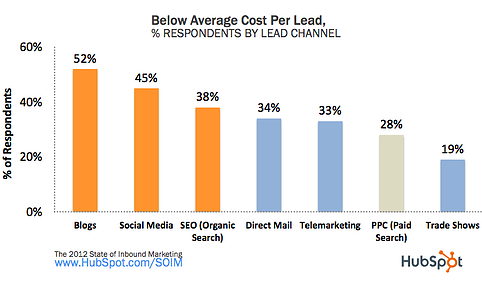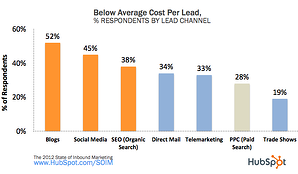Published annually since 2009, HubSpot’s (@HubSpot) State of Inbound Marketing Report surveys professionals who are familiar with their business’ marketing strategy, and reports on the inbound marketing trends and innovations across a variety of industries.
Released in February, the 2012 report supports the past several years’ worth of data to indicate a continued shift in the way businesses approach marketing. Survey respondents confirmed that more small and large businesses are increasing resources dedicated to inbound marketing activities, while simultaneously decreasing spend on more expensive (and less effective) outbound marketing tactics.
Don’t have time to read the entire report? As a HubSpot Gold Certified Partner, we read it and compiled the highlights for you:
Key Findings from the 2012 State of Inbound Marketing Report
Note that the 2012 State of Inbound Marketing report is based on data from a January 2012 survey. Data is from 972 respondents who indicated familiarity with their business’ marketing strategy.
1.) Inbound marketing is less expensive than outbound marketing.
As you would expect, businesses consistently ranked inbound marketing channels as less expensive than outbound marketing channels. Of the listed activities, the top three channels classified as “Below Average Cost Per Lead” include:
- Blogs: 52% of respondents
- Social Media: 45% of respondents
- SEO: 38% of respondents

Tradeshows, direct mail and telemarketing weigh in as the most expensive and were indicated to be significantly “Above Average Cost Per Lead.”
According to the survey, organizations that primarily focus on inbound marketing efforts experience 61% lower cost per lead than outbound marketing focused organizations.
- Average cost per lead for outbound = $346
- Average cost per lead for inbound = $135
How has that changed over time? Not by much. In 2010 and 2011, survey results showed that businesses focused on inbound marketing efforts experienced a 60% and 62% lower cost per lead respectively.
2.) Inbound marketing is more effective in generating qualified leads.
Not only are leads less expensive, they’re also better qualified. Because inbound marketing is based on making your business and content available to prospective buyers when they need/want it, leads generated from these activities are more likely to become customers.
Of survey participants who use closed-loop marketing analytics:
- Leads from inbound links, or referring sites, are five times more likely to become a customer than leads generated from outbound sources.
- Leads from organic search, or SEO, have a 14.6% close rate, while outbound source leads exhibit a 1.7% close rate.
3.) Businesses are either maintaining or increasing inbound marketing budgets.
When asked about the change in budget allocated to inbound marketing from 2011 to 2012, 89% of respondents said they are either maintaining or increasing inbound marketing budgets, with 47% indicating an increase this year.
Why are businesses evolving their budgets? The most common reason for making this decision was past inbound marketing success.
Additional Resources
Want to read more? Check out HubSpot’s complete 2012 State of Inbound Marketing report PDF, or watch the 40-minute, on-demand webinar hosted by HubSpot’s Mike Volpe (@mvolpe) and Melissa Miller (@mcdmiller) for highlights and Q&A.
To learn more about inbound marketing and how it can benefit your business’ marketing strategy, download our free Inbound Marketing GamePlan ebook—an introduction and step-by-step guide on to how to build an inbound marketing strategy for your business.
What success has your business seen from inbound marketing? Do survey results align with your experiences?

%20Logo_BlueOrange_Trademark.png?width=800&height=269&name=Ready%20North%20(RN)%20Logo_BlueOrange_Trademark.png)




.jpg?width=300&name=Services%20Hub%203%20(3).jpg)


COMMENTS